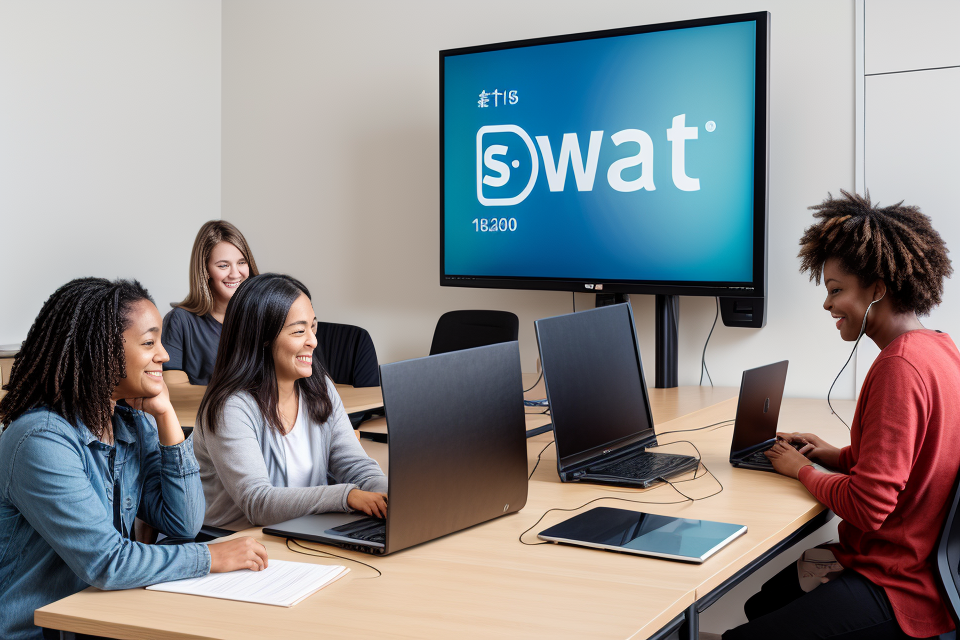
Virtual study groups are becoming increasingly popular as they provide a convenient and accessible way for students to collaborate and learn together. However, virtual environments can also pose challenges when it comes to effective communication and collaboration. In this article, we will explore some tips and tools for maximizing collaboration in virtual study groups, so that you can make the most of your online learning experience. Whether you’re studying online for the first time or looking to improve your virtual study group dynamics, this article has got you covered. So, let’s dive in and discover how to create a virtual study group that’s as productive and engaging as it is fun!
Establishing Effective Communication
Setting Ground Rules
Establishing ground rules is an essential component of effective communication in virtual study groups. These rules help to ensure that all members of the group are on the same page and can work together effectively. Here are some key elements to consider when setting ground rules:
- Clarify expectations: Begin by clarifying the goals and objectives of the study group. This will help members understand what is expected of them and how they can contribute to the group’s success. Be specific about what you hope to achieve and how you plan to do it.
- Schedule regular meetings: It’s important to establish a regular meeting schedule to keep everyone on track and accountable. Determine how often you will meet, and stick to that schedule as closely as possible. Be sure to include all members of the group in the scheduling process to ensure that everyone can attend.
- Assign roles and responsibilities: To ensure that everyone has a clear understanding of their responsibilities, assign specific roles to each member of the group. This could include tasks such as note-taking, research, or presentation preparation. Make sure that everyone is comfortable with their role and has the necessary skills and resources to fulfill their responsibilities.
By establishing clear ground rules, you can help your virtual study group work together more effectively and achieve your shared goals.
Utilizing Virtual Tools
When it comes to virtual study groups, communication is key. To ensure that all members can participate effectively, it’s important to utilize virtual tools that facilitate collaboration. Here are some of the most useful virtual tools for virtual study groups:
Video Conferencing
Video conferencing is an essential tool for virtual study groups. It allows members to meet in real-time, share ideas, and discuss concepts in a way that feels more personal than other forms of communication. There are many video conferencing tools available, including Zoom, Skype, and Google Meet.
Screen Sharing
Screen sharing is another essential tool for virtual study groups. It allows members to share their screens and showcase their work, ideas, and research. This is particularly useful when discussing specific topics or analyzing data. Some popular screen sharing tools include Zoom, Google Meet, and Microsoft Teams.
Collaborative Document Editing
Collaborative document editing is a great way for virtual study groups to work together on projects and assignments. This tool allows members to edit the same document in real-time, which is especially useful when working on group projects or research papers. Some popular collaborative document editing tools include Google Docs, Microsoft Word Online, and Quip.
Overall, virtual tools are essential for virtual study groups to communicate effectively and collaborate on projects. By utilizing these tools, members can stay connected, share ideas, and work together towards common goals.
Fostering Active Participation
Encouraging Diverse Perspectives
In virtual study groups, it is crucial to create an environment that encourages diverse perspectives to enhance learning and promote inclusivity. Here are some tips to help you foster a culture of diversity and inclusion in your virtual study group:
- Create a safe space for sharing: Establishing a safe space for members to share their thoughts and opinions is essential. Encourage members to feel comfortable sharing their ideas without fear of judgment or ridicule. You can achieve this by setting ground rules at the beginning of the study group and ensuring that everyone is aware of them.
- Facilitate discussions: As the facilitator, you play a crucial role in ensuring that discussions are inclusive and diverse. Encourage all members to participate by asking open-ended questions and actively listening to their responses. Avoid dominating the conversation and give everyone a chance to share their perspectives.
- Acknowledge and address biases: Bias can hinder the effectiveness of virtual study groups. Be aware of your own biases and work to address them. Encourage members to acknowledge and challenge their biases and to respect different perspectives.
By implementing these strategies, you can foster an environment of diversity and inclusion in your virtual study group, which will ultimately enhance collaboration and promote effective learning.
Promoting Accountability
Creating a culture of accountability is crucial in virtual study groups to ensure that all members are actively engaged and committed to the group’s goals. Here are some strategies to promote accountability:
Assign tasks and deadlines
Assigning specific tasks and setting deadlines for completion helps members stay focused and on track. It is essential to ensure that tasks are distributed evenly among group members and that deadlines are realistic and achievable. This approach allows for clear expectations and prevents procrastination.
Track progress
Regularly tracking progress helps members stay accountable and motivated. Using project management tools, such as Trello or Asana, allows group members to monitor the progress of tasks and see how their contributions fit into the larger project. Additionally, setting up regular check-ins or status updates during virtual meetings can help keep members on track and address any challenges or roadblocks.
Celebrate achievements
Celebrating achievements, no matter how small, can help boost morale and encourage continued collaboration. Recognizing individual contributions and milestones can help group members feel valued and motivated to continue working towards the group’s goals. Celebrating achievements can be as simple as acknowledging a job well done during a virtual meeting or as elaborate as planning a virtual team-building activity.
Enhancing Group Dynamics
Building Trust and Rapport
Establish Group Norms
Establishing group norms is a crucial aspect of building trust and rapport in virtual study groups. Group norms refer to the shared expectations and behaviors that members of a group agree to follow in order to promote effective collaboration. Some examples of group norms that can enhance trust and rapport include:
- Being punctual and respecting others’ time
- Being respectful and courteous in online communication
- Active listening and acknowledging others’ contributions
- Keeping the conversation focused and on-topic
- Respecting others’ opinions and avoiding personal attacks
By establishing these norms, group members can create a shared understanding of what is expected of them and how they should behave in the virtual environment. This can help to foster a sense of community and belonging, which can contribute to the development of trust and rapport among group members.
Share Personal Experiences
Sharing personal experiences is another effective way to build trust and rapport in virtual study groups. When group members share their personal experiences, they create opportunities for others to connect with them on a deeper level. This can help to build empathy and understanding, which are essential components of trust and rapport.
For example, group members can share their struggles and successes in their academic journey, or they can discuss their personal interests and hobbies. By sharing these personal experiences, group members can demonstrate their vulnerability and authenticity, which can help to break down barriers and foster a sense of connection and community.
Show Empathy and Understanding
Showing empathy and understanding is also important for building trust and rapport in virtual study groups. Empathy involves understanding and sharing the feelings of others, while understanding involves attempting to see things from another person’s perspective.
Group members can demonstrate empathy and understanding by actively listening to others, acknowledging their emotions, and offering support and encouragement. They can also seek to understand the perspectives of others by asking questions and seeking clarification.
By demonstrating empathy and understanding, group members can create a safe and supportive environment in which all members feel valued and respected. This can help to build trust and rapport and enhance the overall effectiveness of the virtual study group.
Managing Conflict
One of the most challenging aspects of virtual study groups is managing conflict effectively. When working in a virtual environment, conflicts can arise due to misunderstandings, different communication styles, or varying perspectives. To ensure a productive and positive group dynamic, it is essential to address conflicts promptly and appropriately. Here are some tips for managing conflict in virtual study groups:
Address concerns promptly
The first step in managing conflict is to address concerns promptly. Ignoring issues or allowing them to fester can lead to further misunderstandings and exacerbate the situation. Virtual study group members should be encouraged to speak up when they feel uncomfortable or have concerns about the group’s dynamics.
It is essential to create a safe and open environment where members feel comfortable expressing their thoughts and opinions. The group leader or facilitator should actively listen to each member’s concerns and ensure that everyone has an opportunity to share their perspective. By addressing concerns promptly, the group can work together to find a solution that works for everyone.
Practice active listening
Active listening is a crucial skill for managing conflict in virtual study groups. When engaging in discussions, it is essential to listen attentively to what others are saying, ask clarifying questions, and seek to understand their perspectives. Active listening can help prevent misunderstandings and encourage empathy and respect among group members.
Group members should be encouraged to focus on the speaker and give their full attention to the conversation. They should avoid interrupting or jumping to conclusions and instead try to understand the speaker’s message before responding. By practicing active listening, virtual study group members can build trust and rapport with one another, which can help mitigate conflicts.
Seek consensus through compromise
When conflicts arise in virtual study groups, it is essential to seek consensus through compromise. Rather than taking a confrontational approach, group members should work together to find a solution that meets everyone’s needs. Compromise involves making concessions and finding common ground, which can help build trust and foster positive relationships.
Group members should be encouraged to approach conflicts with an open mind and a willingness to listen to others’ perspectives. They should try to identify the underlying issues that led to the conflict and work together to find a solution that addresses those issues. By seeking consensus through compromise, virtual study group members can build a more cohesive and collaborative group dynamic.
Leveraging Technology for Enhanced Learning
Organizing Virtual Resources
In today’s virtual world, it is crucial to have an organized system in place to maximize collaboration in virtual study groups. Here are some tips on how to effectively organize virtual resources:
Curate a shared repository
A shared repository is a centralized location where all study materials can be stored and accessed by group members. This can include documents, presentations, and any other relevant files. By having a designated repository, group members can easily access and share materials, eliminating the need for multiple emails or attachments. It is essential to ensure that the repository is regularly updated and organized for easy access.
Use project management tools
Project management tools can be an excellent way to keep virtual study groups organized and on track. These tools allow group members to collaborate, assign tasks, and track progress. Some popular project management tools include Trello, Asana, and Slack. By using these tools, group members can communicate and collaborate more effectively, ensuring that everyone is aware of their responsibilities and deadlines.
Share relevant articles and links
Sharing relevant articles and links is an excellent way to keep group members informed and up-to-date on the subject matter. By sharing these resources, group members can gain new insights and perspectives, leading to more productive discussions. It is essential to ensure that the resources shared are credible and relevant to the group’s topic. One way to do this is by using a shared document or folder where group members can add and access resources.
Exploring Interactive Learning Tools
- Online quizzes and games:
- Provide a fun and engaging way for students to test their knowledge and understanding of course material.
- Encourage friendly competition and can help identify areas where students may need additional support.
- Examples include Kahoot!, Quizlet, and Jeopardy-style quizzes.
- Virtual simulations and role-playing:
- Offer a hands-on approach to learning by allowing students to practice real-world scenarios in a controlled environment.
- Help develop problem-solving and critical thinking skills.
- Examples include simulations in business, healthcare, and engineering.
- Interactive whiteboards and breakout rooms:
- Interactive whiteboards provide a shared space for students to collaborate and share ideas.
- Breakout rooms allow for smaller group discussions and collaborative problem-solving.
- Encourage active participation and can help foster a sense of community among students.
- Examples include Google Jamboard and Zoom breakout rooms.
Measuring Success and Continuous Improvement
Establishing Goals and Objectives
Establishing clear goals and objectives is a crucial step in maximizing collaboration in virtual study groups. Setting short-term and long-term goals can help group members stay focused and motivated, while assessing progress regularly allows for continuous improvement. Adjusting strategies as needed ensures that the group remains on track towards achieving its objectives.
Here are some tips for establishing goals and objectives in virtual study groups:
- Define measurable goals: Goals should be specific, measurable, achievable, relevant, and time-bound (SMART). This makes it easier to track progress and evaluate success.
- Prioritize goals: Determine which goals are most important to the group and prioritize them accordingly. This can help avoid confusion and ensure that everyone is working towards the same objectives.
- Assign responsibilities: Clearly define roles and responsibilities for each group member to ensure that everyone knows what is expected of them.
- Communicate goals: Share goals and objectives with all group members to ensure that everyone is aware of the overall objectives and their individual responsibilities.
- Review progress regularly: Schedule regular check-ins to assess progress towards goals and objectives. This can help identify areas where adjustments may be needed and ensure that the group stays on track.
By establishing clear goals and objectives, virtual study groups can stay focused and motivated, and work together towards achieving their shared objectives.
Embracing Feedback and Reflection
To maximize collaboration in virtual study groups, it is essential to embrace feedback and reflection. Here are some ways to achieve this:
- Encourage constructive feedback: Creating an environment where members feel comfortable giving and receiving feedback is crucial. Encourage them to provide specific, actionable suggestions and discourage negative comments. Group leaders can initiate discussions on what worked well and what didn’t, and facilitate open communication.
- Facilitate group reflection sessions: Schedule regular reflection sessions to discuss the group’s progress, challenges faced, and lessons learned. Encourage active participation from all members, and use these sessions to identify areas for improvement. Group leaders can facilitate these sessions by asking thought-provoking questions and guiding discussions.
- Apply lessons learned to future studies: Document the group’s reflections and use them to inform future studies. Encourage members to apply the lessons learned to their individual and group work, and acknowledge their efforts to implement changes. Group leaders can remind members of the importance of continuous improvement and provide guidance on how to apply the lessons learned.
By embracing feedback and reflection, virtual study groups can continuously improve their collaboration and achieve better outcomes.
FAQs
1. What are some tips for effectively collaborating in a virtual study group?
Collaborating in a virtual study group requires some additional effort to ensure that everyone can contribute and benefit from the group’s activities. One key tip is to establish clear communication channels and guidelines for how the group will work together. This can include setting up a shared online workspace where group members can share notes, documents, and other resources, as well as scheduling regular meetings or check-ins to stay on track and make sure everyone is on the same page. It’s also important to encourage active participation from all group members, and to find ways to build camaraderie and teamwork even when everyone is not physically in the same location.
2. What tools can I use to facilitate virtual collaboration in a study group?
There are many tools available that can help facilitate virtual collaboration in a study group. Some popular options include video conferencing software like Zoom or Google Meet, which allow group members to meet and collaborate in real-time, as well as online project management tools like Trello or Asana, which can help keep everyone organized and on track. Other tools, like shared online documents or whiteboards, can help group members collaborate on notes, brainstorm ideas, and work through problems together. It’s important to choose tools that are easy to use and accessible to all group members, and to take some time to learn how to use them effectively before starting your virtual study group.
3. How can I make sure everyone stays engaged and motivated in a virtual study group?
Staying engaged and motivated can be a challenge in any type of study group, but it can be especially difficult in a virtual setting. One way to help keep everyone motivated is to set clear goals and objectives for the group, and to break down larger tasks into smaller, more manageable steps. It can also be helpful to establish accountability measures, such as regular check-ins or progress reports, to help keep everyone on track. Additionally, finding ways to make the study group experience more enjoyable and engaging, such as incorporating games or team-building activities, can help boost morale and keep everyone motivated.


